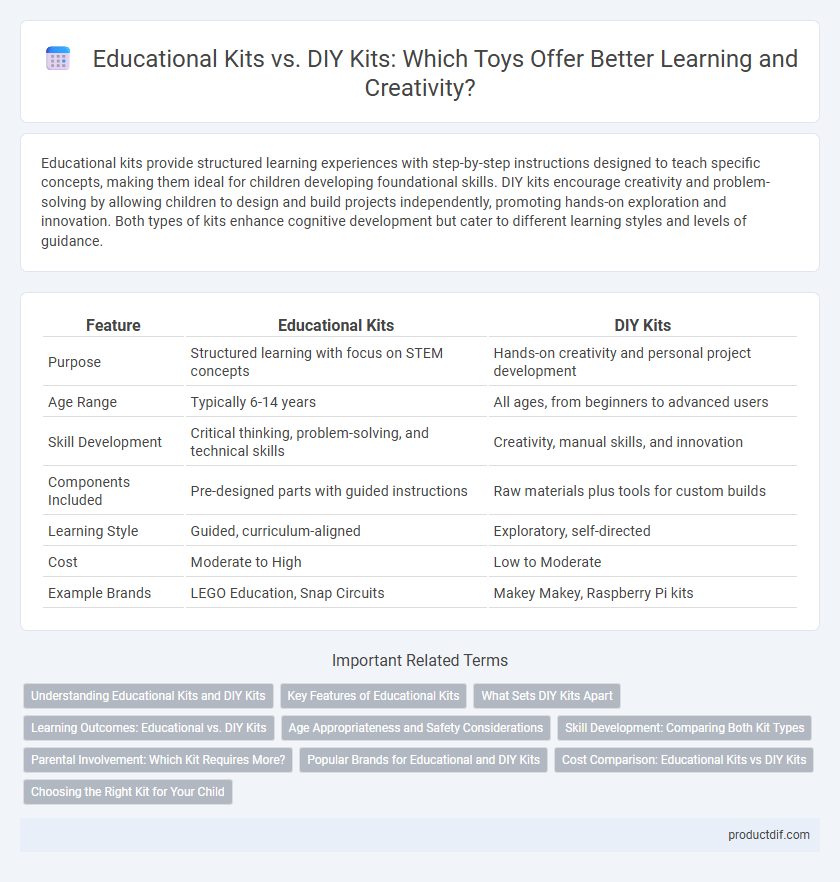Educational kits provide structured learning experiences with step-by-step instructions designed to teach specific concepts, making them ideal for children developing foundational skills. DIY kits encourage creativity and problem-solving by allowing children to design and build projects independently, promoting hands-on exploration and innovation. Both types of kits enhance cognitive development but cater to different learning styles and levels of guidance.
Table of Comparison
| Feature | Educational Kits | DIY Kits |
|---|---|---|
| Purpose | Structured learning with focus on STEM concepts | Hands-on creativity and personal project development |
| Age Range | Typically 6-14 years | All ages, from beginners to advanced users |
| Skill Development | Critical thinking, problem-solving, and technical skills | Creativity, manual skills, and innovation |
| Components Included | Pre-designed parts with guided instructions | Raw materials plus tools for custom builds |
| Learning Style | Guided, curriculum-aligned | Exploratory, self-directed |
| Cost | Moderate to High | Low to Moderate |
| Example Brands | LEGO Education, Snap Circuits | Makey Makey, Raspberry Pi kits |
Understanding Educational Kits and DIY Kits
Educational kits are designed to enhance cognitive skills and knowledge through structured activities that align with specific learning objectives, often incorporating STEM concepts. DIY kits emphasize hands-on creativity and problem-solving by allowing children to assemble or build projects independently, fostering practical skills and innovation. Both types of kits promote developmental growth but target different aspects of learning, with educational kits prioritizing guided instruction and DIY kits encouraging exploration.
Key Features of Educational Kits
Educational kits emphasize structured learning with step-by-step instructions that enhance cognitive development and STEM skills. They often include age-appropriate materials designed to teach scientific concepts, math principles, and problem-solving techniques. These kits promote interactive engagement and foster critical thinking through guided experiments and projects.
What Sets DIY Kits Apart
DIY kits distinguish themselves by offering hands-on learning experiences that foster creativity and problem-solving skills. Unlike educational kits, which often follow structured lesson plans, DIY kits provide open-ended projects that encourage experimentation and innovation. This flexibility allows users to customize their builds, enhancing engagement and deepening technical understanding.
Learning Outcomes: Educational vs. DIY Kits
Educational kits are specifically designed to enhance cognitive skills, problem-solving abilities, and subject-specific knowledge through structured activities and guided instructions. DIY kits emphasize creativity, hands-on experimentation, and independent learning, fostering critical thinking and innovation by allowing children to build and customize projects. Both types of kits contribute to different facets of learning outcomes, with educational kits focusing on curriculum-based skills and DIY kits promoting practical application and self-directed exploration.
Age Appropriateness and Safety Considerations
Educational kits designed for specific age groups often include materials that meet stringent safety standards, reducing risks of choking hazards or toxic substances. DIY kits may have more complex components suitable for older children but require adult supervision to ensure safe handling of tools and small parts. Choosing kits based on recommended age ranges ensures developmental appropriateness while minimizing injury risks.
Skill Development: Comparing Both Kit Types
Educational kits enhance cognitive abilities and critical thinking by providing structured learning experiences tailored to specific subjects like STEM or language arts. DIY kits foster creativity and problem-solving skills through hands-on assembly and open-ended challenges that encourage experimentation. Both kit types contribute uniquely to skill development, with educational kits emphasizing guided knowledge acquisition and DIY kits promoting independent innovation and adaptability.
Parental Involvement: Which Kit Requires More?
Educational kits typically demand higher parental involvement to guide learning objectives, explain complex concepts, and ensure educational outcomes. DIY kits often encourage independent creativity, requiring less direct adult supervision while fostering problem-solving skills. Parental engagement in educational kits enhances cognitive development, whereas DIY kits promote autonomy and hands-on experience.
Popular Brands for Educational and DIY Kits
Popular brands for educational kits include LEGO Education, Thames & Kosmos, and National Geographic, known for their STEM-focused products that enhance learning through hands-on experiments. DIY kit favorites such as KiwiCo, Snap Circuits, and Elenco provide interactive projects that foster creativity and technical skills in children and adults alike. Both categories emphasize quality materials and engaging content, making them leaders in the toy market for educational and DIY enthusiasts.
Cost Comparison: Educational Kits vs DIY Kits
Educational kits often involve higher upfront costs due to the inclusion of curated learning materials and guided instructions that enhance the child's understanding of specific concepts. DIY kits typically cost less, as they provide basic components for assembly without detailed educational content, appealing to budget-conscious consumers seeking hands-on experience. Comparing prices, educational kits can range from $30 to $100, whereas DIY kits usually fall between $15 and $50, making DIY options more affordable but potentially less comprehensive in educational value.
Choosing the Right Kit for Your Child
Educational kits foster critical thinking and STEM skills through guided activities designed to teach specific concepts, making them ideal for structured learning environments. DIY kits encourage creativity and problem-solving by allowing children to build projects from scratch with minimal instructions, suitable for kids who enjoy open-ended exploration. Selecting the right kit depends on your child's learning style, interests, and developmental goals, balancing educational value with engagement.
Educational kits vs DIY kits Infographic

 productdif.com
productdif.com